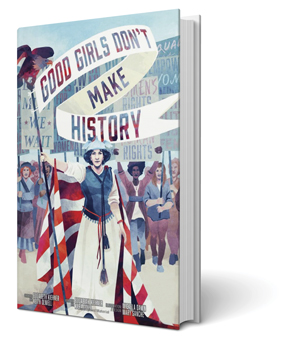
In her new graphic novel, Elizabeth Kiehner, SOC/BA ’98, rewrites a chapter of history that doesn’t get enough ink in textbooks. Good Girls Don’t Make History chronicles women’s 70-year battle for the ballot, culminating in the passage of the 19th Amendment, which celebrated its centennial last year.
“Part of the reason why I [think] women aren’t in a more equal and balanced place today is because we haven’t taken an honest look at what people went through in the past to even get a seat at the table,” says Kiehner, vice president of enterprise transformation at Capgemini Invent in New York City.
She likens years of research to “getting a crash course in women’s history”—the lessons from which will stay with her forever.
“The suffragists inspired me, and I hope, in turn, their story will inspire readers to become more civically engaged and politically active—in ways big and small,” Kiehner says. “We all have the power to be catalysts for change.”
What was the impetus for the book?
I was looking to take on a creative project and anchor it on something of historical significance. The 100th anniversary of women’s suffrage—which seems like it doesn’t get any attention in public school curriculum—was approaching, and that triggered the idea. When we started doing research, we contemplated a podcast or a documentary, before settling on a graphic novel. My husband and I and our two kids are huge fans of graphic novels, so it felt like the right fit.
We’ve framed the narrative around modern-day scenes of girlfriends protesting, moms and daughters voting together, and drawn parallels to what was happening in the past. There’s a lot that has changed. Unfortunately, there’s a lot that has stayed the same.
Why is the story of women’s suffrage best told through a graphic novel?
We went through thousands of photographs at the Library of Congress—all of them black and white, which made it difficult to capture the energy and struggle of what these women were going through. Graphic novels are highly visual, so we thought that would be a great way to tell the story in a colorful, compelling way.
Which suffragist resonated most with you?
I’m partial toward [fellow AU alumna] Alice Paul, whose lifetime commitment to the cause was an inspiration. I’m also drawn to Inez Milholland, who [embodied] the movement. She wasn’t afraid of being theatrical and brought levity and joy to what was a yearslong slog. Even after she died [in 1916], she remained symbolic of the movement.
Women of color were largely excluded from the movement, their contributions overlooked by history. How does your book broaden the narrative?
It was important for us to shine a light on African American women whose stories haven’t been adequately documented, like Sojourner Truth, Ida B. Wells, and Frances Ellen Watkins Harper [the first Black woman to publish a short story in the US]. Future books in the series will focus on African American, Asian American, and Native American women who fought for—and, in many ways, are still fighting for—freedom and equality.
More than 370 people on Kickstarter pledged $13,531 to bring the book to life. Why did you decide to crowdfund the project?
We launched the Kickstarter campaign in summer 2020 as we were coming to the tail end of illustrating the book. My husband and I had been completely funding it out of our own pocket, so I wanted some validation that there was an audience for the book. I also wanted to offset costs, like printing, to get us across the finish line. We had [pitched] publishers in the middle of COVID, but they passed on the project. Then, through the Kickstarter process, three different publishers approached us; we ultimately went with Wide Eyed.
One of your three collaborators was your husband of 20 years, Keith Olwell, SOC/BA ’96, owner and creative director of Proton Studio. What’s it like working with your spouse?
Keith has been my life partner and creative partner since we met at AU. We laugh when we hear couples say they could never work together, because we genuinely love it. I’m an extrovert and Keith is more of an introvert, so we complement each other. It’s not unlike the relationship between Susan B. Anthony and Elizabeth Cady Stanton.
EPILOGUE
Last great book you read?
March, the incredible series of three graphic novels about John Lewis [by Lewis, Andrew Aydin, and Nate Powell]. I read them while I was working on my book, and they were very much in line with the spirit of my work.
Best time to read?
Either in the evening before I go to bed or first thing in the morning.
Best place to read?
If the weather’s nice, outside.
You’re struggling to get through a book. Do you push through or put it down?
Back at AU I double majored in visual media and literature, so I would always soldier on. But now I give myself permission to set it aside or take a break.
Favorite bookstores?
My hands-down favorite is Strand and Forbidden Planet and Midtown Comics for graphic novels [in New York City].